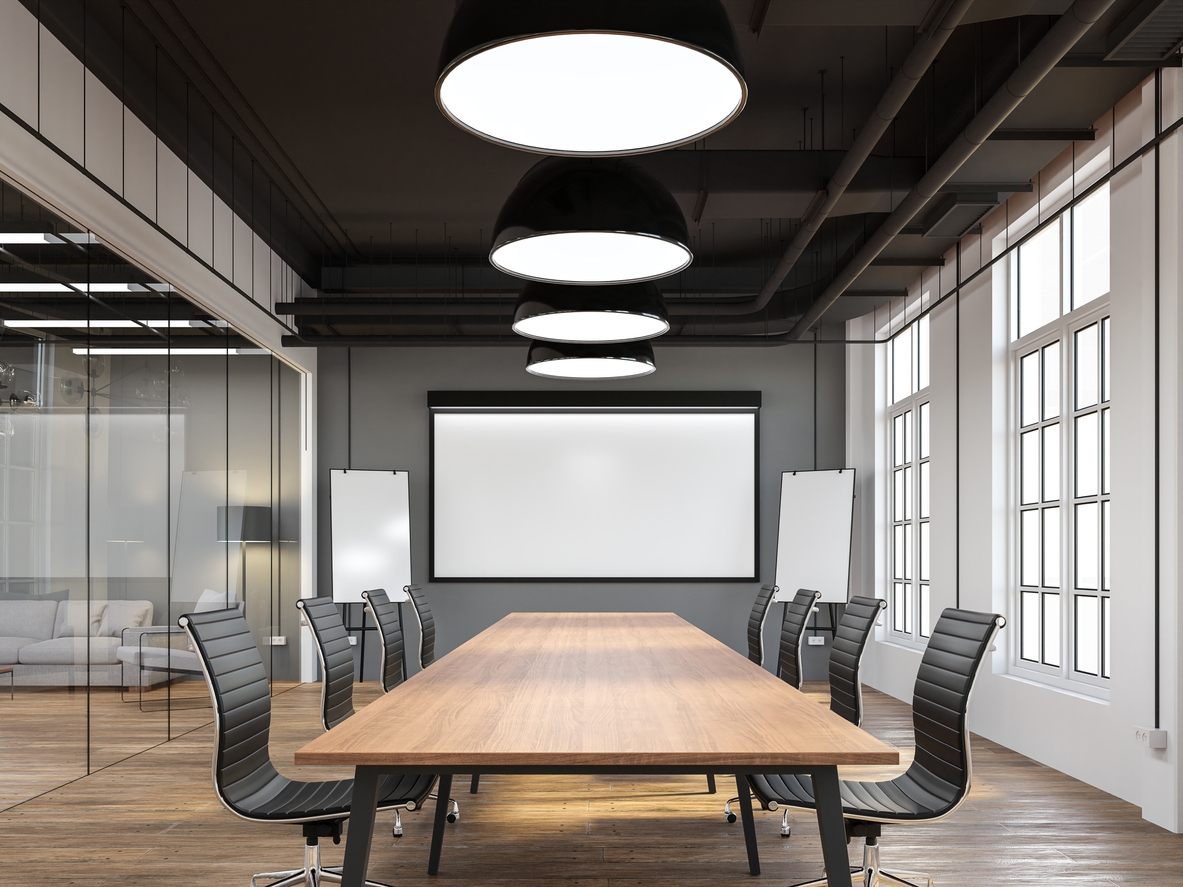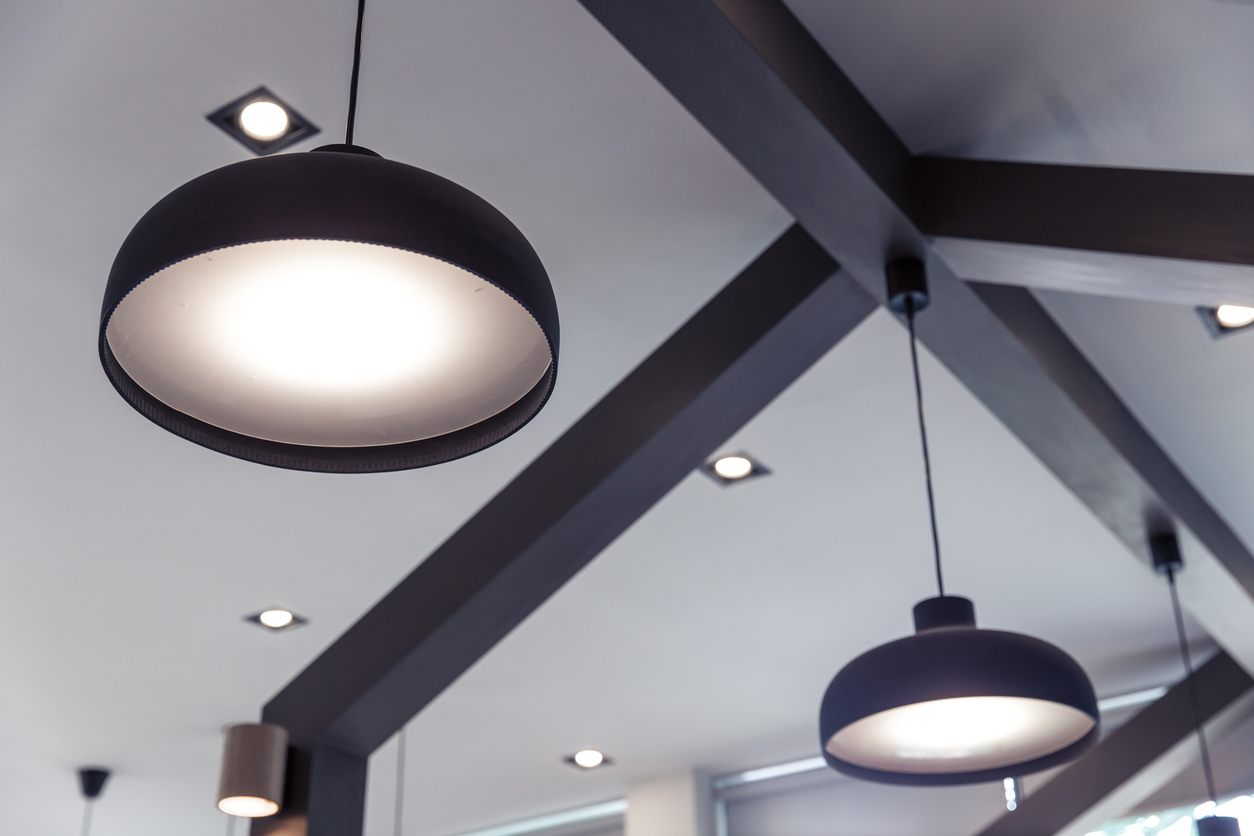Commercial ceiling painting is crucial for maintaining and enhancing a commercial space’s aesthetic and functionality. As a professional painting company, Custom Painting, Inc. understands the transformative effect it can have on your business environment.
Enhancing aesthetic appeal
Creating a cohesive look
Importance of matching ceiling colors with walls and overall decor
- Aesthetic harmony: In commercial spaces, achieving a cohesive look by matching ceiling colors with walls and overall decor is crucial for creating a visually appealing environment. A harmonious color scheme helps make the space look well-thought-out and professionally designed.
- Brand identity: Many commercial spaces are designed to reflect the brand’s identity. Coordinating the ceiling color with the walls and other decor elements can reinforce brand colors and themes, contributing to a more enduring brand presence.
- Psychological impact: Colors have psychological effects on people. Consistent color schemes can evoke specific emotions and responses from visitors or employees. For example, calm and neutral tones can create a relaxed atmosphere, while vibrant colors can energize and stimulate creativity.
- Visual flow: Matching ceiling colors with walls ensures a smooth visual transition, preventing abrupt changes that can be jarring to the eyes. This continuity can make the space feel more cohesive and connected, enhancing the overall experience of the area.
- Professionalism: A well-coordinated color scheme demonstrates attention to detail and professionalism. It shows that the business cares about its appearance, which can positively influence clients, customers, and employees.
Brightening the space
The impact of light-colored ceilings on making spaces look larger and brighter
- Light reflection: Light-colored ceilings reflect more light, which can significantly brighten up a space. This factor is crucial in commercial environments where natural light may be limited, and artificial lighting needs to be maximized.
- Perception of space: Light colors can make a space look bigger and more open. In commercial spaces, especially smaller offices or retail areas, using light-colored ceilings can help create an illusion of more space, making the environment feel less cramped and more inviting.
- Energy efficiency: Brighter spaces often require less artificial lighting during the day, which can lead to energy savings. This factor is critical in commercial settings, where lighting can be a significant part of the operational cost.
- Mood enhancement: Bright and well-lit spaces tend to improve mood and productivity. For employees, working in a brighter environment can reduce fatigue and increase focus. For customers, an illuminated space can be more welcoming and pleasant, enhancing their overall experience.
- Versatility: Light-colored ceilings are versatile and can complement various styles and color schemes. This flexibility is beneficial in commercial spaces that may undergo frequent updates or changes in decor.
Matching ceiling colors with walls and overall decor is essential for creating a cohesive and professional look in commercial spaces. Light-colored ceilings are crucial in brightening the space, making it appear more expansive, inviting, and energy-efficient. Both aspects are crucial in the design and maintenance of commercial environments to ensure they are appealing, functional, and conducive to business operations.
Improving lighting efficiency
Reflecting natural and artificial light
How a well-painted ceiling can enhance light reflection
A well-painted ceiling can significantly improve the reflection of both natural and artificial light in a commercial space. Here’s how:
- Choice of paint color: Light-colored paints, particularly white and other light neutrals, are highly reflective. They can bounce natural and artificial light throughout the room, making the space brighter and more open.
- Gloss level: The sheen of the paint also affects light reflection. Higher gloss paints, such as semi-gloss or satin, have a smoother surface reflecting more light than matte or flat finishes. However, balance gloss with the need to hide ceiling imperfections, as high-gloss paints can make flaws more noticeable.
- Uniformity: A uniform coat of paint without streaks or patches ensures even light distribution. Uneven paint can create shadows and dark spots, negatively impacting the overall lighting quality.
- Reflectance value: Paint manufacturers often provide a Light Reflectance Value (LRV) for their products. A higher LRV indicates better light reflection. Choosing paints with high LRV can significantly enhance the brightness of a space.
Benefits for energy efficiency and reduced lighting costs
- Reduced need for artificial lighting: Enhanced light reflection means that the space can benefit more from available natural light, reducing the need for artificial lighting during daytime hours. It can lead to substantial energy savings.
- Lower electricity bills: Less reliance on artificial lighting decreases electricity consumption, resulting in lower utility bills. This factor is particularly beneficial in large commercial spaces where lighting constitutes a significant portion of the energy budget.
- Extended lifespan of light fixtures: Reducing the use of artificial lighting can extend the lifespan of light bulbs and fixtures, leading to further cost savings in maintenance and replacements.
- Environmental benefits: Using less electricity helps reduce a business’s carbon footprint, aligning with sustainability goals and potentially enhancing the company’s reputation among environmentally conscious consumers.
Enhancing work environments
The role of good lighting in boosting employee productivity and customer experience
Employee productivity
- Improved focus and concentration: Adequate and well-distributed lighting reduces eye strain and fatigue, allowing employees to stay focused and work more efficiently. Proper lighting can decrease the occurrence of headaches and other discomforts associated with poor lighting conditions.
- Enhanced mood and morale: Natural light, in particular, has been shown to improve mood and energy levels. Employees who work in well-lit environments are often happier and more satisfied with their work conditions, leading to higher morale and productivity.
- Safety: Good lighting improves visibility, reducing the risk of accidents and injuries in the workplace. It is crucial in environments where precision and attention to detail are necessary.
Customer experience
- Aesthetic appeal: A well-lit space is more inviting and can positively influence a customer’s perception of the business. Bright, welcoming environments can attract more customers and encourage them to spend more time and money in the space.
- Product Display: Proper lighting is essential in retail settings for effectively showcasing products. It can highlight the features and details of products, making them more appealing to customers and potentially increasing sales.
- Ambiance and Comfort: Lighting plays a crucial role in setting the ambiance of a space. Whether it’s a cozy restaurant, a vibrant store, or a professional office, the correct lighting can create the desired atmosphere, enhancing the overall customer experience.
The strategic use of ceiling paint to enhance light reflection can offer significant benefits for energy efficiency and the quality of the work environment. By improving lighting conditions, businesses can boost employee productivity, enhance customer experience, and achieve cost savings.
Address wear and tear
Hiding stains and imperfections
Common issues
- Water stains: Water stains on ceilings often result from leaks in the roof or plumbing issues. These stains can range from small yellowish spots to large brown patches.
- Discoloration: Over time, ceilings can become discolored due to age, smoke, or exposure to moisture. It can make the ceiling look dirty and old.
- Cracks: Structural movement, settling of the building, or temperature changes can cause cracks in the ceiling. These can range from hairline cracks to more significant splits.
Techniques for preparation and painting
- Cleaning the surface: Before painting, it is crucial to clean the ceiling thoroughly to remove dust, cobwebs, and grease. It ensures that the paint adheres properly.
- Priming: Using a stain-blocking primer is essential for ceilings with stains and discoloration. Primers designed to block stains prevent them from bleeding through the new paint.
- Filling cracks and holes: Fill small cracks and holes with a joint compound or spackle. Once dried, sand the area smooth to ensure an even surface.
- Sanding: Sanding the ceiling helps smoothen any rough patches and ensures better paint adhesion. Use fine-grit sandpaper for the best results.
- Painting: Use high-quality ceiling paint. These paints are often formulated to reduce drips and provide a flat finish that helps hide imperfections. Two coats may be necessary for full coverage.
Preventing further damage
Protective benefits of fresh paint
- Sealing: A fresh coat of paint acts as a sealant, protecting the ceiling material from moisture, a common cause of stains and mold growth.
- UV protection: High-quality ceiling paints often contain UV blockers that prevent discoloration and fading caused by sunlight.
- The barrier to contaminants: Paint creates a barrier that helps protect the ceiling from dust, smoke, and other airborne pollutants that can cause discoloration and deterioration over time.
Regular maintenance for long-term protection
- Inspection: Regularly inspect ceilings for signs of damage or wear. Early detection of issues like leaks or cracks can prevent more significant problems in the future.
- Cleaning: Periodic cleaning can prevent the buildup of dirt and grease, which can lead to staining and discoloration. Use a gentle cleaner suitable for painted surfaces.
- Repainting: Repainting the ceiling every few years can help maintain its appearance and provide ongoing protection. High-traffic areas or those exposed to moisture, like kitchens and bathrooms, may require more frequent attention.
- Addressing leaks promptly: Fix any leaks in the roof or plumbing as soon as they are detected to prevent water damage that can lead to stains and structural issues.
Proper preparation and painting techniques can effectively conceal stains and imperfections on commercial ceilings, enhancing their appearance and extending their lifespan. Regular maintenance and a fresh coat of paint can also prevent further damage, ensuring the ceiling remains in good condition for years. Addressing aesthetic and protective aspects can help maintain a clean, safe, and visually appealing commercial space.
Complying with health and safety standards
Ensuring clean and safe environments
Importance of maintaining clean, well-painted ceilings in compliance with health standards
Maintaining clean and well-painted ceilings is crucial for several reasons:
- Aesthetics and professionalism: A well-painted ceiling is vital for a professional and welcoming environment to boost customer satisfaction and the business’s image.
- Hygiene and safety: Clean ceilings prevent the accumulation of dust, mold, and other contaminants that can affect indoor air quality and health. In sectors like healthcare and food services, this is particularly important to prevent the spread of bacteria and other pathogens.
- Regulatory compliance: Many industries have strict regulations regarding health and safety standards. Regular maintenance, including ceiling painting, ensures compliance with these regulations, avoiding potential fines and legal issues.
Examples of commercial sectors where ceiling painting is crucial
- Restaurants: Maintaining a clean and hygienic environment is mandatory in the food service industry. Grease, smoke, and other contaminants can accumulate on ceilings, affecting aesthetics and hygiene. Regular painting helps maintain a clean look and meets health inspection standards.
- Healthcare facilities: Hospitals, clinics, and other healthcare facilities require an exceptionally high standard of cleanliness. Clean, well-maintained ceilings help control infections and maintain a sterile environment. Regular painting also ensures that any damage or mold growth is promptly addressed.
- Retail stores: A clean and well-maintained ceiling enhances customers’ shopping experiences. It reflects the store’s commitment to cleanliness and care for the environment in which customers spend their time.
- Office buildings: Clean ceilings contribute to a professional atmosphere and improve the overall work environment for employees.
Using low-VOC and safe paints
Benefits of using environmentally friendly and safe paint products
- Healthier indoor air quality: Low-VOC (Volatile Organic Compounds) paints emit fewer pollutants in the air, significantly reducing the risk of respiratory issues and other health problems for occupants. It is crucial in spaces where people spend long periods, such as offices and healthcare facilities.
- Environmental impact: Eco-friendly paints have a minimal impact from production to application. They reduce the emission of harmful chemicals, contributing to a cleaner and safer environment.
- Compliance with green building standards: Using low-VOC and safe paints can help commercial spaces meet green building standards such as LEED (Leadership in Energy and Environmental Design). This approach benefits the environment and enhances the building’s marketability and reputation.
How these products contribute to healthier indoor air quality
- Reduced toxic emissions: Traditional paints can release VOCs that contribute to indoor air pollution, causing headaches, dizziness, and long-term health issues. Low-VOC paints minimize these emissions, creating a safer environment for both workers applying the paint and occupants of the building.
- Odor control: Low-VOC and zero-VOC paints often have little to no odor, which is beneficial in settings like healthcare and education, where strong odors can cause discomfort or trigger allergies and asthma.
- Sustainable and safe ingredients: Many environmentally friendly paints use natural ingredients and safer chemicals, which reduces the overall toxicity in the indoor environment. It is critical in sensitive areas such as children’s schools and hospitals.
Complying with health and safety standards while painting commercial ceilings involves maintaining a clean and visually appealing environment, as well as using safe and sustainable paint products. This approach ensures the well-being of occupants, adherence to regulations, and a positive environmental impact.
Professional expertise and efficiency
The advantage of hiring professionals
Benefits of Professional Ceiling Painting Services
Quality:
- Expertise: Professional painters have extensive training and experience in ceiling painting, ensuring a flawless finish. They know the best techniques and materials for different ceilings and environments.
- Consistency: Professionals can achieve a consistent look across large areas, avoiding common issues like streaks, uneven coverage, or paint drips.
- Durability: High-quality paints and proper application techniques ensure that the paint job will last longer, reducing the need for frequent touch-ups or repaints.
Efficiency:
- Speed: Professionals can complete the job more quickly than amateurs due to their experience and use of advanced tools. They can also work during off-hours to minimize disruption.
- Coordination: A professional team can efficiently manage all aspects of the project, from preparation to cleanup, ensuring they complete the job within the agreed timeframe.
Safety:
- Equipment: Professional painters have the necessary safety equipment and training to work on high ceilings or in difficult-to-reach areas, minimizing the risk of accidents.
- Health considerations: They know about safe practices for handling paints and chemicals, protecting both workers and the building’s occupants.
Overview of our company’s process and attention to detail
Initial consultation:
- Assessment: We conduct a thorough inspection of the space to understand the specific requirements and challenges of the project.
- Recommendations: Based on our assessment, we provide recommendations on the best materials and techniques to use.
Preparation:
- Surface preparation: Proper preparation is crucial to a quality paint job. We ensure all surfaces are clean, dry, and properly primed.
- Protection: We protect floors, furniture, and other areas from paint splatters and dust.
Painting:
- Skilled application: Our team of trained painters uses the best tools and techniques to apply the paint evenly and smoothly.
- Attention to detail: We pay close attention to edges, corners, and other particulars to ensure a perfect finish.
Cleanup and inspection:
- Thorough cleanup: We ensure the space is clean and free of paint residue or debris once the job is completed.
- Final inspection: Our final inspection ensures the work meets our high standards and the client’s expectations.
Time and cost savings
How professional services can save time and reduce costs in the long run
Efficiency and speed:
- Quick turnaround: Professional painters complete the job more quickly due to their experience and efficient work processes, minimizing downtime for your business.
- Scheduling flexibility: We can work during off-hours or weekends to avoid disrupting your daily operations.
Cost-effectiveness:
- Avoiding mistakes: Professionals minimize mistakes that can lead to additional costs, such as fixing drips, uneven coverage, or paint spills.
- Long-lasting results: High-quality, durable paint jobs reduce the need for frequent repaints, saving money over time.
Examples of efficient project completion without disrupting business operations
Nighttime or weekend Work:
- Minimal disruption: Our team can work outside of your regular business hours to ensure that the painting process does not affect your operations.
Phased approach:
- Sectional painting: We can paint your space in phases, allowing different areas to remain operational while others are being painted. This approach is beneficial for large commercial spaces.
Rapid project completion:
- Efficient teamwork: By deploying a well-coordinated team of painters, we can complete projects swiftly, ensuring that your business can return to normal operations as soon as possible.
Project management:
- Coordination: Our project managers oversee all aspects of the painting process, ensuring each phase is completed on time and within budget. This attention to detail and coordination helps prevent delays and additional costs.
By hiring professional ceiling painting services, businesses can ensure high-quality results, efficient project completion, and significant time and cost savings while maintaining a safe and disruption-free environment.
Conclusion
Not overlooking ceiling painting in commercial spaces brings substantial long-term benefits. A well-painted ceiling can enhance the aesthetic appeal, contribute to a more welcoming and professional environment, and even improve lighting conditions and energy efficiency. These advantages not only create a positive impression on clients and customers but also contribute to the well-being and productivity of employees.
We encourage business owners to consider Custom Painting, Inc.’s professional ceiling painting services to realize these benefits. Our licensed and insured paint crew brings expertise and quality to their work, ensuring that your commercial space looks its best and functions optimally. Contact Custom Painting, Inc. by phone at 510-795-0903 or leave a message on our contact page today to learn how we can transform your ceilings and elevate your business environment.





